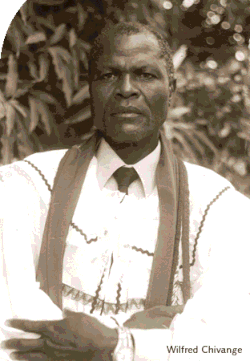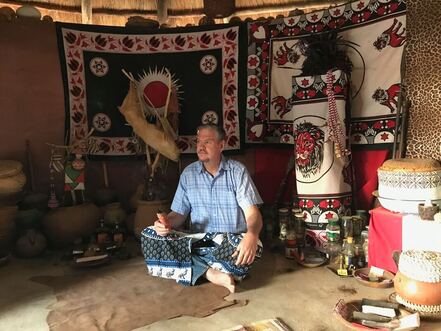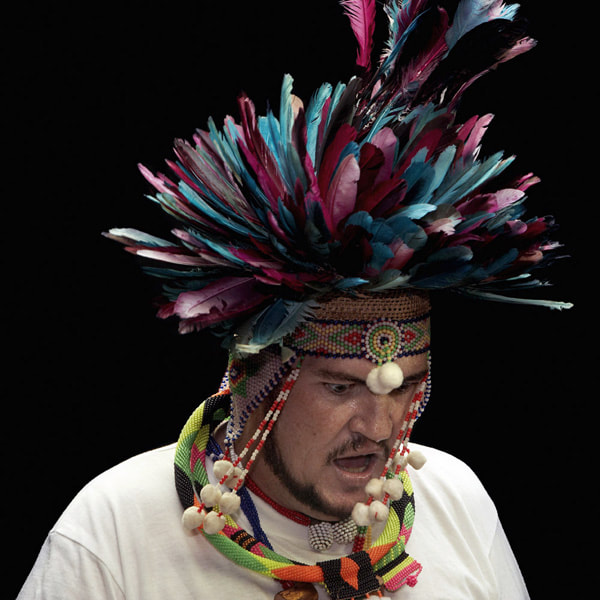About Niall Campbell (Phokojwe)
Niall Campbell was born and brought up on a farm in rural South Eastern Botswana. From an early age he had considerable interest in both African culture and African spiritual practice. Niall's interests grew to include the cultural beliefs and spiritual practices of several diverse cultures across the globe.
In 1982 at the age of 12 he was having difficult and unexplainable occurrences in his life including petit mal seizures and visitations by spirits. His father took him to the Bushmen / San healers at Tsodilo who danced and divined his calling. Niall became apprenticed to Hosea Mashudu Chaoke, a Venda/Shangaan traditional healer from Zimbabwe. Niall spent five years learning diagnostic divination and treatment from him.
While training with Mr Chaoke, Niall travelled to the Tsodilo Hills in North Western Botswana, here he was initiated as a medium for Nature Spirits of the type which inhabit hills and caves. These spirits appear in the form of predatory or carnivorous animals and play an important role in traditional society by regulating the interaction between humans and nature. Mr Samtjao Mareka of the Hambukushu people conducted the initiation.
After Mr. Chaoke's death in 1987, Niall's training continued with Simon Sibanda, a traditional healer and Apostolic Church bishop. Mr Sibanda was from the Ndebele people of Zimbabwe. Under his tutorage Niall learned the laws and typical behaviour of ancestral spirits, how they interact with the living, and the plant and animal derived medicines that are used to regulate human interaction with them.
At this time Niall started a practice in traditional medicine while holding a job in a factory in Gaborone.
Niall's training continued under Mr Motseothata Gaotsholwe who is of mixed K/hu Bushman and Kgalagadi decent. Mr Gaotsholwe trained Niall in medicinal herbalism and furthered his training in the laws and behaviour of nature spirits.
In 1997 Niall spent a month in a monetary in Nepal, here he studied the practices of the Dzogchen School of Tantric Buddhism.
During his retreat in Nepal Niall made a commitment to earn his living through a "Path of Rightful Livelihood."
One of the implications of this was that his factory work had to change and so he started work with a community empowerment NGO based in Canada. While in Canada Niall worked closely with Cree and Algonquin traditional healers, and lived and worked in Innu and Inuit communities in Labrador.
In 1999 when he was 29 and while in Canada Niall had a reoccurrence of the particular problems that had initially put him on the path of African medicine. He was forced to return to Botswana and do the final initiation ceremony to become a Sangoma (a medium for ancestral and tutelary spirits).
Soon after the initiation, while praying on the Tsodilo Hills in Northern Botswana, Niall had a vision in which he was told to build a teaching centre for the training of students as traditional healers.
Mpanda ye Ngwenyama (the Lodge of the Black Lion) trained its first two Sangomas in 2001. As the vision had promised, the Lodge grew into a large establishment with is own funding. It has trained over 20 Sangomas.
The courses provided there include both Sangoma and Malombo training (Malombo being the Venda equivalent of Sangoma). In addition, there have been courses in African cosmology and indigenous environmental law that have been well attended by civil servants, environmentalists and community development workers from various regions of Africa and the rest of the world.
At present Niall is involved in the running of the various courses and training at the Lodge, and is actively involved in his practice in traditional medicine. He spends his time between Botswana and Cape Town.
In 1982 at the age of 12 he was having difficult and unexplainable occurrences in his life including petit mal seizures and visitations by spirits. His father took him to the Bushmen / San healers at Tsodilo who danced and divined his calling. Niall became apprenticed to Hosea Mashudu Chaoke, a Venda/Shangaan traditional healer from Zimbabwe. Niall spent five years learning diagnostic divination and treatment from him.
While training with Mr Chaoke, Niall travelled to the Tsodilo Hills in North Western Botswana, here he was initiated as a medium for Nature Spirits of the type which inhabit hills and caves. These spirits appear in the form of predatory or carnivorous animals and play an important role in traditional society by regulating the interaction between humans and nature. Mr Samtjao Mareka of the Hambukushu people conducted the initiation.
After Mr. Chaoke's death in 1987, Niall's training continued with Simon Sibanda, a traditional healer and Apostolic Church bishop. Mr Sibanda was from the Ndebele people of Zimbabwe. Under his tutorage Niall learned the laws and typical behaviour of ancestral spirits, how they interact with the living, and the plant and animal derived medicines that are used to regulate human interaction with them.
At this time Niall started a practice in traditional medicine while holding a job in a factory in Gaborone.
Niall's training continued under Mr Motseothata Gaotsholwe who is of mixed K/hu Bushman and Kgalagadi decent. Mr Gaotsholwe trained Niall in medicinal herbalism and furthered his training in the laws and behaviour of nature spirits.
In 1997 Niall spent a month in a monetary in Nepal, here he studied the practices of the Dzogchen School of Tantric Buddhism.
During his retreat in Nepal Niall made a commitment to earn his living through a "Path of Rightful Livelihood."
One of the implications of this was that his factory work had to change and so he started work with a community empowerment NGO based in Canada. While in Canada Niall worked closely with Cree and Algonquin traditional healers, and lived and worked in Innu and Inuit communities in Labrador.
In 1999 when he was 29 and while in Canada Niall had a reoccurrence of the particular problems that had initially put him on the path of African medicine. He was forced to return to Botswana and do the final initiation ceremony to become a Sangoma (a medium for ancestral and tutelary spirits).
Soon after the initiation, while praying on the Tsodilo Hills in Northern Botswana, Niall had a vision in which he was told to build a teaching centre for the training of students as traditional healers.
Mpanda ye Ngwenyama (the Lodge of the Black Lion) trained its first two Sangomas in 2001. As the vision had promised, the Lodge grew into a large establishment with is own funding. It has trained over 20 Sangomas.
The courses provided there include both Sangoma and Malombo training (Malombo being the Venda equivalent of Sangoma). In addition, there have been courses in African cosmology and indigenous environmental law that have been well attended by civil servants, environmentalists and community development workers from various regions of Africa and the rest of the world.
At present Niall is involved in the running of the various courses and training at the Lodge, and is actively involved in his practice in traditional medicine. He spends his time between Botswana and Cape Town.
Alec Campbell
Niall's father Alec was an influential figure in the history of Botswana. Alec was a prolific writer on many aspects of Botswana, from archaeology to history and from environment to culture and society. In all, he published nearly 100 articles, books and reports, as well as government policy evaluations and commissions of inquiry. His books include The Guide to Botswana (1980), History of Botswana (1984,1997, in press) co-authored with Thomas Tlou, African Rock Art (2001) co-authored with David Coulson, and Tsodilo Hills: Copper Bracelet of the Kalahari (2010), co-edited with Larry Robbins and Michael Taylor.
Alec provided advice to researchers, development workers, and non-government organisations working on minority and indigenous issues in Botswana, especially those concerning the San. In addition, he had a profound influence on the development of archaeology in Botswana and in the mentoring and support of archaeologists, students and museum staff, not least because of his role as founding Director of the National Museum. One area of Botswana that Alec particularly loved was the Tsodilo Hills where he spent large amounts of time over more than five decades. A great personal friend of their Mbukushu and Ju/'hoansi (San) residents, he helped to document Tsodilo's rich archaeological record by recording rock art and through work at Depression Shelter, White Paintings Shelter, Rhino Cave, Ancestors Cave, the specularite mines, and other sites. The highlight among numerous publications was the book he co-edited in order to share the information that so fascinated him with a diverse audience, Tsodilo Hills, Copper Bracelet of the Kalahari. Alec was also instrumental in getting the Tsodilo Hills named as a National Monument and then as Botswana's first World Heritage Site and helped set up a museum there.
Alec provided advice to researchers, development workers, and non-government organisations working on minority and indigenous issues in Botswana, especially those concerning the San. In addition, he had a profound influence on the development of archaeology in Botswana and in the mentoring and support of archaeologists, students and museum staff, not least because of his role as founding Director of the National Museum. One area of Botswana that Alec particularly loved was the Tsodilo Hills where he spent large amounts of time over more than five decades. A great personal friend of their Mbukushu and Ju/'hoansi (San) residents, he helped to document Tsodilo's rich archaeological record by recording rock art and through work at Depression Shelter, White Paintings Shelter, Rhino Cave, Ancestors Cave, the specularite mines, and other sites. The highlight among numerous publications was the book he co-edited in order to share the information that so fascinated him with a diverse audience, Tsodilo Hills, Copper Bracelet of the Kalahari. Alec was also instrumental in getting the Tsodilo Hills named as a National Monument and then as Botswana's first World Heritage Site and helped set up a museum there.
Lineages

We are informed and guided by teachers of the following Southern African traditions:
Pfumbi - Hlengwe:
Hosea Chauke
(Diagnostics, Divination systems)
Hambukushu:
Samotjao Mareka
(Nature spirits)
Tswana - Shangaan Sangoma tradition:
Tshwene Morage - Majoye lineage
(Ritual process, Initiation rites)
Basarwa - Bakgalagadi:
Motseothata Gaotsholwe
(Herbalism)
Ndebele - Kalanga:
Simon Sibanda
(Ancestral spirits, Herbalism)
Hlengwe - Ndau:
Wilfred Chivange
(Lineage rituals)
Pfumbi - Hlengwe:
Hosea Chauke
(Diagnostics, Divination systems)
Hambukushu:
Samotjao Mareka
(Nature spirits)
Tswana - Shangaan Sangoma tradition:
Tshwene Morage - Majoye lineage
(Ritual process, Initiation rites)
Basarwa - Bakgalagadi:
Motseothata Gaotsholwe
(Herbalism)
Ndebele - Kalanga:
Simon Sibanda
(Ancestral spirits, Herbalism)
Hlengwe - Ndau:
Wilfred Chivange
(Lineage rituals)


